Veteran’s Testimony – Albert I. Davis 105th Evacuation Hospital
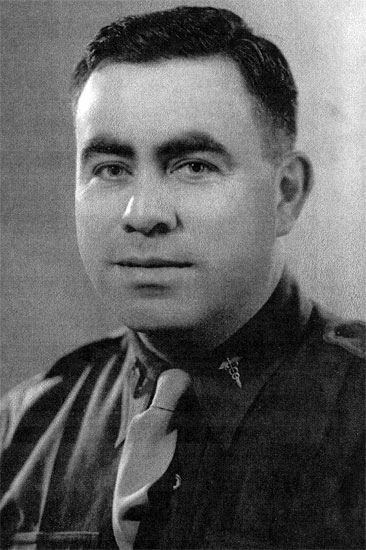
Picture of Captain Albert I. Davis, MC, O-276929 (1909-1979).
Introduction:
Albert Isidore Davis was born 2 May 1909 in Boston, Massachusetts. He was to spend the major part of his life dedicated to Medicine. He would practice General Medicine and Surgery for 7 years as a successful Physician and General Practitioner (starting in 1936), and was also a Plant Physician for shipyards and steel fabrication trades, in which he often acted as Medical Adviser to Industry.
In 1925 Albert I. Davis sent in his application and was enrolled in the CMTC Program. He attended the ‘White’ Infantry Instruction Course at Ft. Devens, Ayer, Massachusetts, from 1 August to 30 August 1925, organized under the auspices of the “Citizens’ Military Training Center”. The program was authorized by the National Defense Act of 1920, which provided young volunteers with 4 weeks of military training in summer camps each year from 1921 to 1941 (discontinued after 1941). Applicants had to be physically and mentally fit, 17 years old or over, and preferably High School students or recent graduates. Camps taught youngsters the advantages and responsibilities of citizenship and provided mental, moral, and physical training in different Branches of the Army. Albert was assigned to C Company, 13th Infantry Regiment. This allowed Al to join the Army Reserves later on, after electing to continue his higher education. After taking the above course, he was recommended for enlistment in the Regular Army, National Guard, or Enlisted Reserve corps, as a Private, and qualified for appointment as a Non-Commissioned Officer or Specialist and to continue training in the ‘Blue’ Course.
Citizens’ Military Training Camps were conducted by the National Defense Act of 1920 (which governed all military training). The Government paid the expenses of those attending, consisting of transportation to and from camp, uniforms, food, and medical attendance. The object was to bring together young men of high type from all sections of the country on a common basis of equality and under the most favorable conditions of outdoor life; to stimulate and promote citizenship, patriotism, and Americanism; and, through expert physical direction, athletic coaching, and military training; to benefit the young men individually, and bring them to realize their obligations to their country.
There were 4 instruction courses: Basic – Red – White – Blue. Applicants for the Red, the White, and the Blue courses were able to select the Branch of Service in which to be trained.
Basic Course: for physically fit male United States citizens, 17 to 24 years of age. Previous military training not required. Applicants must possess average general intelligence, be able to read and write English, and be of good moral character. This course provides preliminary military training, including physical developments, athletics, school of the soldier, squad and company drill, rifle marksmanship, first aid, camp sanitation, personal hygiene, military courtesy, meaning of discipline, and studies in citizenship. Those taking this course will be given an opportunity to qualify for the next higher, or Red Course. Attendance at this course does not constitute any present or future contract of enlistment in the Army of the United States.
Red Course: for physically fit male United States citizens, 17 to 25 years of age. Applicants must be graduates of the Basic Course or have had equivalent military training, must possess average general intelligence, be able to read and write English, and be of good moral character. This course provides training in different Branches of the Army: Infantry, Field Artillery, Cavalry, Coast Artillery, Corps of Engineers, and Signal Corps. Advanced instruction in the subjects covered in the Basic Course is included. Those who take this course will be given the opportunity to qualify in the same Branch for the next higher, or White Course. Attendance at this course does not constitute any present or future contract of enlistment in the Army of the United States.
White Course: for physically fit male United States citizens, 18 to 28 years of age and Enlisted Men of the Army of the United States. Applicants must have a Grammar-School education or its equivalent, possess qualities of leadership, and be of good moral character. This course provides training in different Branches of the Army: Infantry, Field Artillery, Cavalry, Coast Artillery, Corps of Engineers, and Signal Corps, for the purpose of qualifying candidates as Specialists and Noncommissioned leaders. This course is open to candidates who have completed the Red Course and who have been recommended to pursue the White Course, to selected citizens who have had military training equivalent to the Red Course, and to selected Enlisted Men of the Army of the United States. Those who attend will be given the further opportunity to qualify in the same Branch for the next higher, or Blue Course, but it will be required that they possess, or show that they will later possess, the mental and physical qualifications to become Officers in the Officers’ Reserve Corps. This requirement will be fully explained to all candidates before or during the White Course. Attendance at this course does not constitute any present or future contract of enlistment in the Army of the United States.
Blue Course: age limits, 19 to 31. Qualifications for admission are as follows: applicants must be Warrant Officers or Enlisted Men or selected civilians who are physically fit. Applicants must have not less than a completed High-School education or its equivalent, and must possess the personality, appearance, tact, bearing, and general adaptability which will fit them, after further training in the Blue Course, to take the necessary mental and physical examination to be Officers of the Officers’ Reserve Corps. Applications from Warrant Officers and Enlisted Men must receive approval of the immediate Commanding Officers. Note: graduation from the Blue Course does not itself confer legal eligibility for appointment in the Officers’ Reserve Corps.
A young man who attends a Citizens’ Military Training Camp renders voluntary service to the U.S. Government and the certificate obtained is evidence of his patriotism and loyalty. Those who complete the Course have received the typhoid-paratyphoid inoculation and smallpox vaccination.

Military Training Certificate for the Infantry “White” Course, followed at Cp. Devens, Massachusetts, dated 30 August 1925, obtained by Albert I. Davis.
Albert’s civilian education consisted of 4 years of High School in Boston, (1924-1927) and another 4 years of study at the Massachusetts College of Pharmacy, also in Boston (1927-1930). Subsequently, he then went to the Middlesex College of Medicine and Surgery in Waltham (1930-1936) to major in Medicine. A special one-month course was taken at Northeastern University, in Boston, covering Industrial Safety Engineering (1941).
Albert Davis took internships in General Medicine, at the Monmouth Memorial Hospital, New Jersey (12 months in 1935), and another spell at the Hazard Hospital (12 months in 1936), followed by an 8-month residentship in Medicine and Surgery at the Toms River Hospital, New Jersey, in 1936.
Further to his civilian education, Albert Davis attended a number of Service Schools related to Military Medicine, such as:
The Army Medical Field Service School, Carlisle, Pennsylvania, where he had already taken first courses in 1930, and to which he returned in order to follow a further 8 weeks of General Medicine in 1932. Next, followed the Chemical Warfare School, (Edgewood Arsenal), Aberdeen, Maryland, where he followed another 8-week course on Treatment of Gas Casualties (1942). An additional course was taken at the 114th General Hospital, Texas, for 8 weeks of Tropical Medicine (1943). This was later followed by some 2 weeks at the General Medicine Maintenance School (1943).
In 1930, Al Davis was already a member of the Officers’ Reserve Corps, in which he was appointed 2d Lieutenant of the Medical Administrative Corps on 28 August. He was later promoted to 1st Lieutenant in the Medical Corps, in which capacity he joined active Federal service with the Army of the United States, on 2 September 1942. His promotion as Captain in the AUS followed on 4 June 1943 (while still serving in the ZI).
Captain A. I. Davis, MC, O-276929, was finally assigned to the 105th Evacuation Hospital, joining the unit on 12 April 1944 (a year after the Hospital had been activated, i.e. 1 April 1943) at Ft. Jackson, South Carolina, its station in the ZI. The days at Ft. Jackson were rough ones as everyone plunged into the final training phase before being transferred overseas. Physical fitness tests were given, bivouacs were set up, and more and more inspections took place. The Hospital unit received a new Commanding Officer in the person of Lt. Colonel Allan A. Craig (from Thompson, Iowa) who joined the Hospital on 15 May 1944 (he received his promotion to full Colonel, a few weeks later). Final showdown inspections were made and the unit departed from Ft. Jackson by rail on 10 August.
Overseas:
The Hospital arrived at Cp. Kilmer, New Jersey (POE Staging Area) on 11 August 1944 and after initial processing was completed (shots and inspections), passes were authorized and lots of people took off for New York or one of the New Jersey neighboring towns. Unfortunately, all good things must come to an end. On 25 August, the unit was alerted and on 27 August, the 105th departed on its great adventure overseas. Climbing onto a ferry, personnel were taken to the “queen of the seas”, the “Queen Elizabeth”, lying majestically in her birth. While marching up the gangplank, Red Cross girls served fresh lemonade and doughnuts. On sailing the next morning, 28 August 1944, every man rushed to catch a last glimpse of the US of A. Everyone was filled with nostalgia as the vessel steamed out of the harbor with the proud Statue of Liberty silhouetted against the New York skyline …
The trip was rather uneventful. The very first days, some ships were sighted, such as destroyers and escort carriers, and combat planes flew over, but then some days passed without seeing anything, except for some flying fish and a school of porpoises. Things began to change when the “QE” neared the British coast. And after being inspected by British patrol planes and encountering a lonely British warship, the troop transport proceeded through a heavily mined area, steaming up the Firth of Clyde the morning of 3 September. Approaching the misty Scottish shores, the “Queen Elizabeth” passed into the anchorage area, where a number of ships lay at anchor, ships of all nations, both troop and warships.
England:
Debarkation at Glasgow, 4 September, took place in lighters under a drizzling rain. After a short briefing, all personnel entrained in carriages bound for the city of Bournemouth. Everything about this country seemed so different from America, the port area, the suburbs, the lowlands, the highlands, even the people.
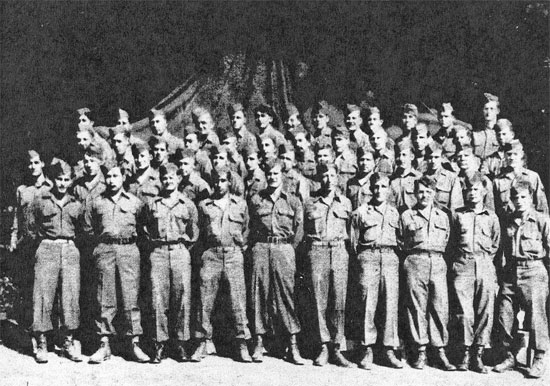
Picture illustrating part of the staff pertaining to the different Ward Sections. Captain Albert I. Davis operated in Ward 1 (pre-op ward).
In a letter sent home, dated 7 September 1944, Capt. Davis wrote about being in a swell little place, and that he went swimming with some fellow Officers, and had a fine time. Of course he couldn’t divulge the location (this was Bournemouth –ed) because of military censorship. As he was looking for a present or a souvenir to send home to his wife (Helen –ed), he stated he had some difficulty finding something satisfactory, and added that many things were quite expensive and/or rationed in England. He further wrote that notwithstanding the hardships of war, the English people were really very nice, and English kids were cute, their favorite expression being “Got any gum, chum?”
The 105th Evac Hosp would almost spend a month in Bournemouth, once a ‘resort’ city, where it remained from 5 to 22 September 1944. Daily contacts took place with the local population, there were moonlight walks along the beach, swimming parties, visits to local pubs, dances at the Pavilion, entertainment at private homes, trips to London, Bath, Christchurch, Liverpool, and other interesting places. The British proved to be a very hospitable people. Learning to drink English beer, proved quite an experience (quite some difference with the way of serving and drinking beer back home –ed).
Continental Movements:
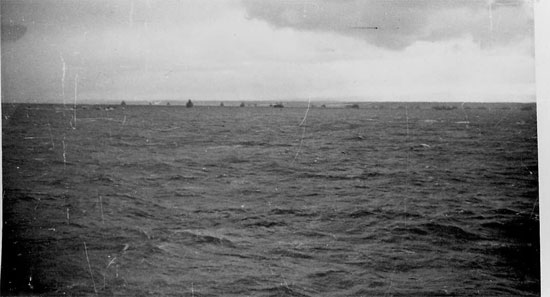
Picture taken by Captain A. I. Davis, before disembarking at Omaha Beach. View taken from aboard ship 5 October 1944, showing the French coastline in the background.
New orders were received, instructing the 105th to travel to Southampton and a Staging Area designated Camp C-5 (Bushfield Camp, south of Winchester -ed). Orders were to embark in Southampton for transport across the Channel to France. Everyone remembers the barracks with straw mattresses, the poor food, and the good-looking Canadian Nurses. The unit spent 12 days at C-5, and after reaching Southampton 3 October 1944, Officers and EM embarked on the English steamer S/S “Duke of Wellington”. Rendezvous point was somewhere off the Isle of Wight. Excellent sleeping quarters were obtained, and then came the grand cuisine: canned herring with cold tomato sauce, and greasy raw sausages. Because of a rough sea, landing had to be delayed because of the very high surfs. Finally, LSTs pulled alongside and the steamer began to disgorge her sick but thankful human cargo. Shipwrecks dotted the water as well as steel anti-landing obstacles, reminding everyone that this had been a bloody battlefield only a few months ago. After landing on Omaha Beach 5 October, the Officers were transported to the Valognes Staging Area (this must have been Field “E” or Transit Area No. 2? –ed) for the night. The next day reminders of the battles fought on and after D-Day were still present for everyone to see. War had passed through the area for sure, and there was enough evidence of this.
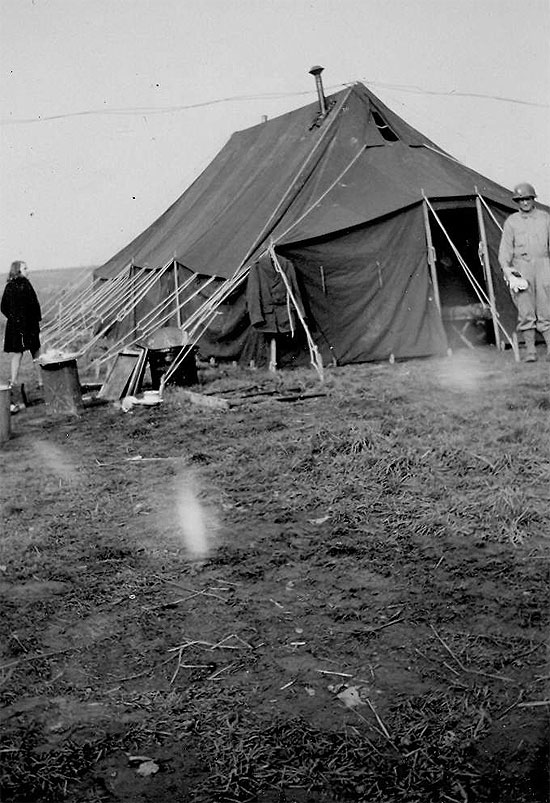
Partial view of the 105th Evac Hosp bivouac site (vicinity of Tongres) in Belgium. Shown here is the M1942 Squad Tent. Picture taken 17 or 18 October 1944.
On 11 October 1944, Officers, Nurses, and Enlisted personnel left for Carentan, where the group entrained (first acquaintance with the French 40 & 8 boxcars -ed) to begin its journey across part of France to a new station in Holland. The train sometimes ran parallel with the front, and often within sight of artillery duels. The unit arrived at Maastricht Railway Station, Holland, on 16 October, and after detraining continued its route by motor convoy to Tongres, Belgium, where it arrived the same day. At the selected bivouac area, the Officers were quartered in ward tents, the Nurses were housed in a nearby Château, and the EM pitched their small pup tents. The cold, the rain, the mud, played havoc with morale, spirits were low, and everyone was glad to move on to Maastricht, Holland, again on 28 October 1944. The 105th’s return to Maastricht and its prolonged stay there (28 October 1944 to 09 February 1945) proved to be the Hospital’s first ‘real’ encounter with war, as patients from the bitter fighting around Aachen starting coming in for treatment. While news of the war was first-hand, it was localized, but everybody eagerly listened to the radio, to the news, trying to make out what was to come next. Battles seemed to progress favorably. Then it came suddenly: 16 December 1944, the enemy had broken through in the Belgian Ardennes, and a feeling of panic gripped all personnel. Things got serious, and the Hospital was now receiving casualties from different units trying to stop the enemy advance. To this was added the threat of becoming surrounded or cut off. Tank columns rumbled past day and night and moving convoys blocked the roads. Wild rumors floated around but strict censorship prevented corroborating any of them. Those were hectic and wild days, with all men making preparations for advance or retreat … nevertheless, Christmas rolled past before they even knew, much as any other day of the week, except for the wonderful dinner the cooks served.
During his assignment with the 105th Evac, Captain Albert I. Davis mainly worked in the Pre-Operations Ward (or Ward 1), where medical personnel gave the patients their first care and treatment, after admission. Together with fellow Officers like Capts. Robert Garrett , Jacob Kincov, and Samuel O. Perry, Capt. Davis alternated in examining incoming patients, reading X-rays, and classifying the wounded as to priority for surgery. When the rush was on other Officers were on the job. Officers like Lts. Sexton, Lloyd, Burwell, Garson, and Smith had many varied experiences and were always on the job, including the Enlisted personnel who saw more than just day duty! Working through blackout hours was not exceptional, everything was aimed at getting the patients to surgery and receiving others from the battlefield.
Captain A. Davis in one of his letters, written in the latter part of December 1944, explained how the 105th spent its first Christmas overseas. While in Holland, the 105th Evacuation Hospital celebrated the event with a party for the entire Hospital, all personnel of the Auxiliary Surgical Team (detached from the 5th Auxiliary Surgical Group), and of all things, Albert Davis had to dress as Santa. Everyone had a good time, and the soldiers then went down to the recreation hall to start a Xmas service (the hospital was set up in a building –ed). It was really something to see, soldiers with rifles or side arms in a fairly peaceful setting. This made Al Davis dream and hope for everyone to be home by the next Christmas!
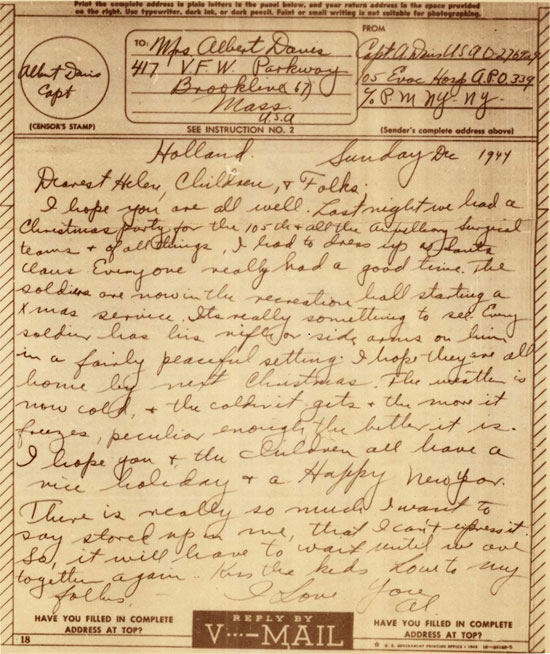
Copy of V-Mail sent by Captain Albert I. Davis to his wife, out of Holland (written after Xmas 1944).
A welcome rest period followed and New Year came along. On 31 December 1944, Officers and Nurses were celebrating in the second story wing of the hospital building, and most of the Enlisted Men were occupied at small personal parties or playing cards. Early in the evening, the antiaircraft battery a block away started firing. Everyone could hear planes droning overhead and occasionally a zooming sound was heard as if one came down to strafe. Now and then someone would get up to check the blackouts but no one thought about going to the air raid shelter, just in case … Then the noise outside began to increase as more batteries joined in. Suddenly there was a loud drone as a bomber came in low, and a penetrating scream terminated in a terrible explosion that shook the whole building. Glass and debris flew all over the place. Some members of the command rushed to the dispensary to take care of those who had been wounded by the attack, others took up posts and directed the rest to places of safety, still others went into the wreckage and chaos of the Officers’ wing to help Officers and Nurses out. Glass, broken furniture, and rubble of collapsed masonry filled the wing. Lights streamed through holes blown by the bombs. First aid was given wherever necessary. Noise grew less and less, excitement dropped, order was restored, and it was time to rest and go to sleep, for those who could. The next morning a big job awaited everyone, and details were formed to start clearing away debris, estimating damage, and initiating repairs. The bombs had landed about 50 feet from the building, fortunately missing it. But their force had shattered all windows in the near vicinity and the bitter winter cold penetrated the cardboard inserts. By the time things settled down, with major repairs finalized, it was time to move on to another change of station.

Partial view of one of the Operating Rooms of the 105th Evac Hosp. Picture most probably taken either at Maastricht or Sittard, Holland.
Sittard, Holland, was to be the next stop. After arriving at its new location, 9 February 1945, the 105th moved into some buildings owned by the local Parochial School. One morning at 0300, the night crew was drawn outside by the wild bombing of Ninth TAC bombers and Army long range artillery; when the latter became silent, shorter range artillery took over. Skies were lighted by an unearthly glow, and people told each other; “the crossing of the Roer River has begun.” And then everybody went back inside getting prepared for the casualties that were expected. Off duty hours were spent getting to know some of the local people in whose homes many had been billeted. Lasting friendships resulted from these cold and rainy days, when 105th personnel were invited by the local population who shared their meagre comforts and resources with their liberators. For many these were some of the most enriching moments of their Army experience. Allied troops had been able to exploit the German retreat after the fighting in the Ardennes sector, and were now about to penetrate the ‘Fatherland’.
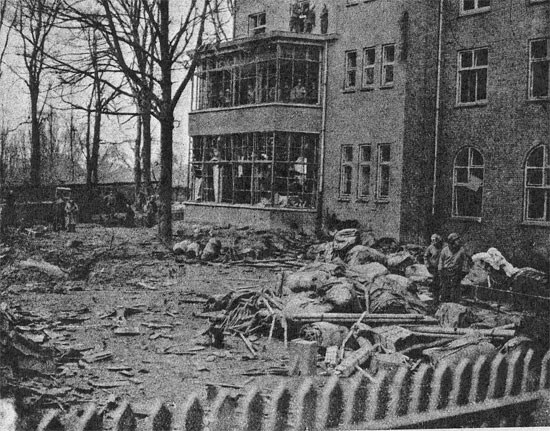
Picture illustrating some buildings being inspected in view of a possible housing for the 105th Evac Hosp. Probably shot in Maastricht, Holland, around the end of 1944.
Germany:
On 8 March 1945, the 105th Evac packed and moved into some buildings at Mülhausen, Germany. Until now the unit had lived and operated among a friendly civilian population. Being on enemy soil now, this was to be a new experience. The building was a former Girls’ School run by the Nuns. The Hospital was very busy and there was only time to see but a little of Germany, so while keeping active, some people added to their collections of local ‘souvenirs’, waiting for the big moment when the Allies would jump the Rhine. For days and nights German positions were hit by planes and artillery, lighting the skies at night. Then the race was on, and the armored and infantry divisions struck out. Supply lines kept the unit awake for several nights as they rumbled past in the darkness. Orders were received and the 105th crossed the mighty Rhine River on 1 April, on its way to a new hospital site in the vicinity of Wulfen, Germany. The rain accompanied the unit and setting up 40 ward tents in heavy rain, on soggy ground, with mud everywhere, and ambulances waiting to deliver their load of casualties, was not an easy task, to say the least. The days at Wulfen (luckily only a short period, i.e. from 1 to 10 April 1945 –ed) certainly earned the title applied to it: “Hell Hole.” The 105th functioned well, but only because everybody gave up precious hours of sleep in order to operate properly and efficiently. It was the same kind of spirit among the Allied troops that made the exploitation of the Rhine crossing the success that it was. Because of the rapid movement of the Allied Armies, the Hospital soon found itself in the rear, although heavy fighting was still going on not 15 miles away in the Roer pocket. The Army ordered the Hospital to make a 24-hour move to another location, Bad Oeynhausen, Germany, where it arrived the same day (10 April 1945 –ed). A Clearing Company was left behind to take care of the remaining patients, while the major part of the Hospital pulled out on the Autobahn and sped forward by motor convoy. Arriving at night, the unit already pulled out the next morning (the new location was never used –ed), moving on to the city of Hannover which was reached on 11 April 1945. Allied spearheads had merely gone around the town, and the hospital was the very first American unit in! Snipers were still active, and small bands of armed enemy troops were still around, so the 84th Infantry Division moved in the next day to conduct mopping up operations. A large building was taken over and the hospital set up. Souvenir hunting got started, and their number proliferated, a wide aggregation of cameras, field glasses, pistols, daggers, knives, were scrounged, and after filling out the official forms, everything was sent home by state-bound mail. The Hospital ‘liberated’ a few civilian cars which were put to good use.
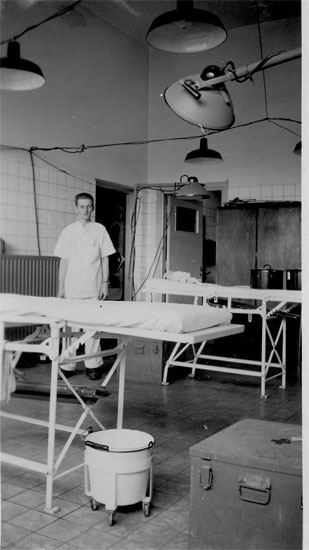
Another partial view of the same O.R. (no action at this stage).
After the liberation of the Bergen-Belsen Concentration Camp by British forces on 15 April 1945 (11th British Armoured Division, Second British Army), a detachment of the 105th Evac was sent to the camp site to provide medical support, Captain A. Davis was on the team, and was confronted with the horrible living conditions and the tragic state of the camp survivors. Another American unit that helped with evacuation and transportation was D Platoon, 567th Motor Ambulance Company (AFS contingent attached to the 21st Army Group) which assisted British and Canadian medical teams during a period of about 7 weeks (April/May 1945).
V-E Day came with its accompanying celebrations, and consumption of ‘certain’ fluids (designated ‘buzz bomb juice’ by the EM –ed) helped people release their repressed feelings (hence Hannover’s nickname: Hangover). The war was over, and the question was, when would the 105th go home? Radio reports stated that the Ninth US Army was on its way home, but was this true? If so, what about the 105th Evac? Consequently letters from the ZI expressed joy over the return of their loved ones, and while this certainly raised morale, no one was sure when this would effectively take place. The unit then moved on to its new station; a bivouac at Bad Nauheim, where it arrived on 11 June (the hospital would remain in the same location, and under tentage, from 11 June to 5 August 1945).
On 9 April 1945, ComZ established the Assembly Area Command to operate Camps and Staging Areas designated to receive units marked for Redeployment and to house them during processing. Each Camp needed a dispensary, and a number of fixed hospital beds which had to be staffed. MD transients passing through the camps (on their home to the ZI or to the Pacific) were often retained for the work. Some of those Assembly Areas were huge and required considerable medical support. One of the largest operated near Marseille, under command of Delta Base Section. Eventually it operated 5 General and 3 Station Hospitals (60,000 Americans were stationed in the Delta Base Section) operating between Biarritz and Nice, as well as a 2,000-member German medical establishment.

Picture showing German PW laborers at work in the “Delta Base Section” Staging Area, near Marseille, France (April 1945).
Final Assignments:
Meanwhile, Capt. Albert Davis had left the 105th Evacuation Hospital, for a new assignment with the 5th Auxiliary Surgical Group (attached to Ninth US Army), starting 1 June 1945. In a letter to his wife, dated 9 June 1945 (mailed from Germany), he wrote that receiving mail was quite difficult now because of all the moving about of the hospital, however he tried to write at every possible opportunity, now that the war in Europe was over. It seemed as if he was destined to continue his ‘around-the-world’ journey, in lieu of being returned home. Nevertheless, Capt. Davis indicated that in a very short time he would be in southern France, indicating to his wife that she might suddenly not hear from him for as long as 6 weeks, adding that it might be possible to get mail off the boat … this seemed to indicate that his return to the States was likely to be imminent.
Another letter followed on 20 June 1945, mailed from Marseille, France. Al Davis described that the weather was hot and that there was a lot of dust around his area. Luckily there were plenty of showers and swimming opportunity, with real warm water and nice beaches. The weather was so hot at times, that people were only wearing shorts and nothing else, and while it was very hot during daytime, the nights were nice and cool. Not knowing what to think of the future, the Officer stated that “this Jap business can’t last much longer”.
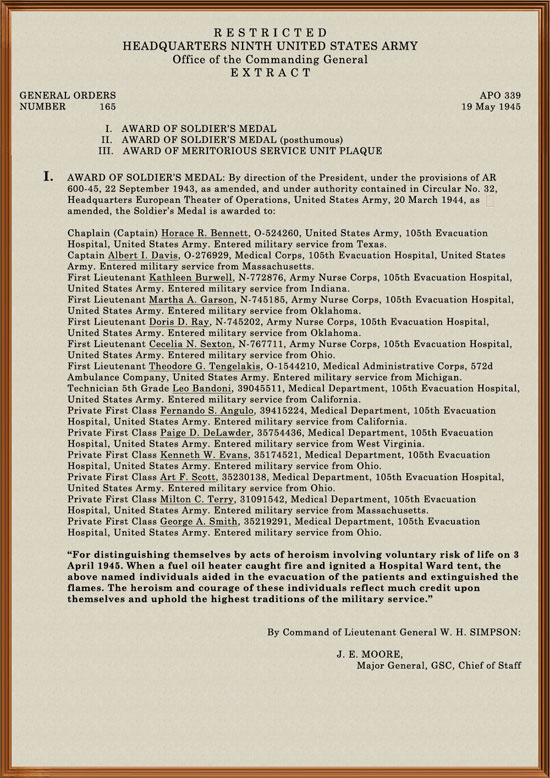
Example of the Soldier’s Medal Award issued to personnel of the 105th Evacuation Hospital.
Click to enlarge.
On 8 July 1945, Captain A. I. Davis was assigned to the 165th General Hospital (which had landed in France 24 September 1944). He still seemed to be stationed in or around Marseille, because in a new letter addressed to his wife and 2 children, dated 20 August 1945, he mentioned that American troops were now moving in all directions, and that the Port of Marseille is now a major embarkation port to the USA. He also mentioned having received some encouraging reports indicating servicemen were going home based on the results of their ASR score. On 23 of August, Albert Davis was expected to drive from Nice to Marseille (most probably the Delta Base Section Staging Area near Marseille –ed) by jeep to reach his new location. He also further indicated that he had reached the number of points required to be sent home, and stated that in 2 to 3 months time the whole area would be cleared of American troops. He did reach his new location, and another assignment, which started on 24 August 1945, attaching him as Medical Officer to the Medical Detachment of the 2755th Engineer Combat Battalion.
Above assignment however wouldn’t last very long, because on 5 September 1945, Davis received new orders sending him on TD with the 159th Evacuation Hospital (this would be his last assignment. He would be relieved from active duty on 8 September 1945 (as per RR-5, Demobilization ) and shipped home before end of the month.
His active service, including quite a stretch in ETOUSA-European Theater of Operations, US Army, (later redesignated USFET-United States Forces European Theater) lasted from 2 September 1942 to 7 January 1946.
Record of the various assignments held by Capt. Albert I. Davis, MC:
22 October 1942 : Commanding Officer of the 30th Medical Regiment (Armored), Cp. Barkeley, Texas, ZI.
8 September 1943 : Commanding Officer of the 606th Medical Clearing Company (Separate), attached to the 240th Medical Battalion.
14 December 1943 : Medical Officer with Company D, 328th Medical Battalion (Clearing Company), organic part of the 103d Infantry Division.
Medical Officer, member of the Surgical & Urological Service, Station Hospital, Ft. Jackson, South Carolina, ZI.
12 April 1944 : Medical Officer with the 105th Evacuation Hospital, in the ZI and serving in the ETO. Supervised the Shock Team and Receiving Sections of the Pre-Op Ward.
1 June 1945 : Medical Officer with the 5th Auxiliary Surgical Group, part of the 1st Medical Group, attached to Ninth US Army 5 Sep 44 – 5 May 45 in the ETO.
8 July 1945 : Medical Officer with the 165th General Hospital, serving under USFET. Operated as Surgical Ward Officer.
24 August 1945 : Medical Officer with the Medical Detachment, 2755th Engineer Combat Battalion, which served in Rhineland, Ardennes-Alsace, and Central Europe.
5 September 1945 : Medical Officer with the 159th Evacuation Hospital (SM), serving with USFET.
8 September 1945 : relieved from active duty.
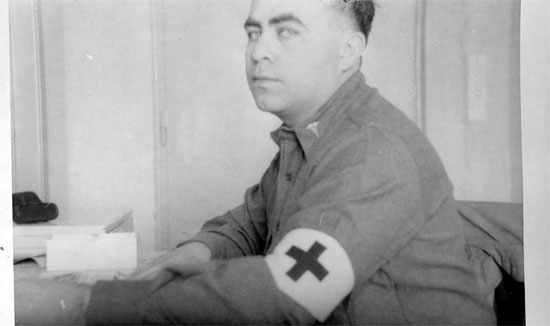
Late war picture of Captain A. I. Davis, MC, who served as a Medical Officer with the 105th Evacuation Hospital in the E.T.O. 1944-45.
Captain Albert I. Davis, MC, O-276929, spent a total of 2 years, 3 months, and 1 day in continental service, and 1 year, 1 month, and 5 days in foreign service (ETO) with the US Army Medical Department, acting as a Medical Officer, General Duty (MOS 3100) and General Medicine & Surgery (MOS 3150) on various assignments.
Starting active service on 2 September 1942, Capt. A. I. Davis was finally relieved from active duty on 8 September 1945. After spending a short while in Europe, achieving an ASR score of 88 points (at 2 Sep 45) he was returned to the Zone of Interior, where he arrived on 2 October 1945. He was sent on to the Ft. Devens, Ayer, Massachusetts, U.S. Army Reception & Separation Center, where he was officially relieved of active service on 7 January 1946.
We are truly grateful to Harold R. Davis, son of Capt. Albert I. Davis (O-276929), for sharing his Father’s personal military reminiscences, V-mail correspondence, and personal pictures with the MRC staff, enabling us to compile and edit this personal testimony.
